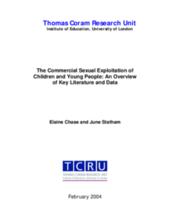The overall aim of this review was to provide an accessible overview of information relevant to the commercial sexual exploitation of children and young people in the UK, including policy and legislation, published and unpublished literature, and statistical data relating to: the extent of commercial sexual exploitation of children and young people in the UK; the characteristics of those affected and those known to perpetrate exploitation; the types of preventive strategies; and the approaches that assist young people to exit and recover from abusive situations.
Three main areas of exploitation were focused upon: abuse through prostitution; abuse through pornography; and the trafficking of children and young people to and through the UK for the purposes of commercial sexual exploitation. A combination of library and Internet searches were used, combined with sources of data identified through the National Plan steering group. The review begins with definitions of key terms used in relation to the commercial sexual exploitation of children and young people. It then considers the international and national policy and legislative frameworks for protecting children and prosecuting perpetrators of abuse.
Overall, the largest amount information was found in relation to young people exploited through prostitution. This highlighted the range of vulnerability factors, the processes used to engage young people in prostitution and the types of support strategies available to those exploited or at risk of exploitation. This showed that although comprehensive support services are provided in some places, provision is patchy. Furthermore, there has been little impact evaluation to date on the outcomes for those accessing support services.
Rather less information is available on the scale of child pornography or the links between the use of pornography and other forms of sexual abuse. The Internet as a modern technology for proliferating child pornography is discussed, alongside its role in providing opportunities for paedophiles to access and ‘groom’ children for sexual purposes. The complexities of providing adequate protection for children as they gain wider access to the Internet through mobile phones are also discussed.
Finally, the review provides a summary of key findings in relation to the trafficking of children to and through the UK for the purposes of commercial sexual exploitation. It highlights that there is limited available data on the scale of the problem and limited protocols or mechanisms in place to support those at risk.
The study concludes with a summary of research that is currently underway that will go further towards supporting the research base for this important area of work. A number of recommendations are made in order to fill apparent gaps in knowledge. These include further research on the issues surrounding young asylum seekers and their vulnerability to abuse through prostitution; further strengthening the knowledge base on effective practice in supporting vulnerable young people; further research on British born children being moved across the country for the purposes of sexual exploitation; and further research on the relationship between use of the Internet and other forms of abuse against children and young people, including grooming for prostitution.
©Thomas Coram Research Unit, Institute of Education, University of London

